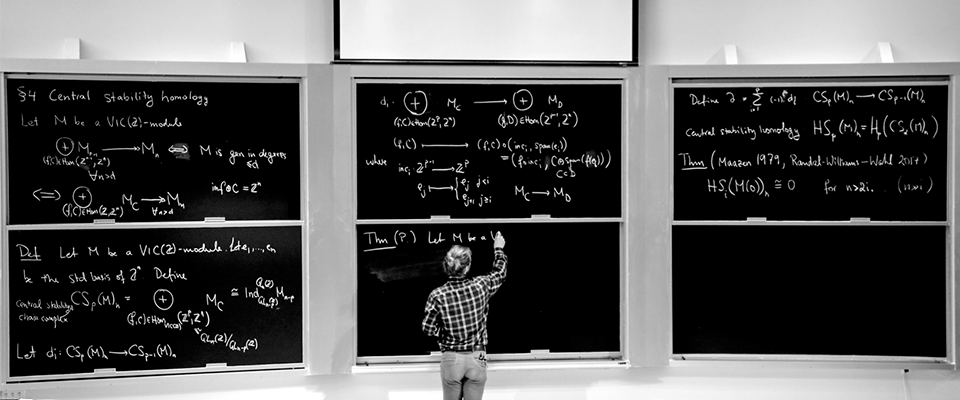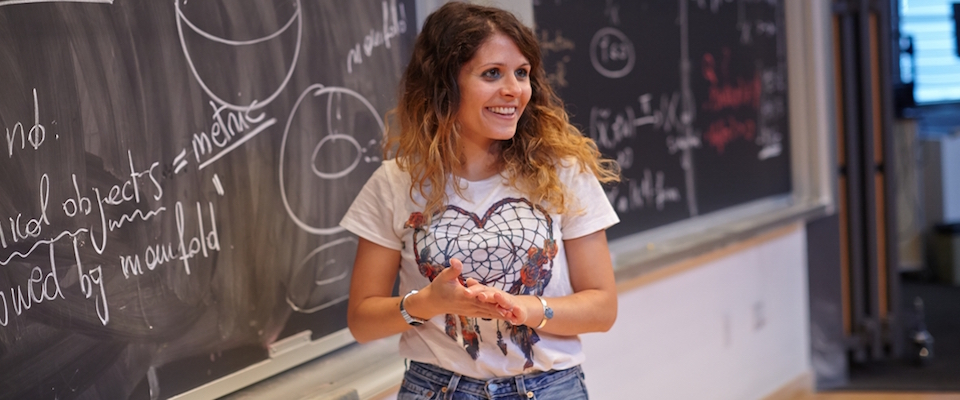Filmmaker Kyung Lee never dreamed she’d become a dealer. But bringing her first feature-length documentary to fruition required money she simply didn’t have. What she did have, however, was an idea for getting high-quality product and access to exclusive clientele.
It all started about a year prior when UC Berkeley math professor David Eisenbud was a visiting professor at University of Tokyo. His host said to him, “You know, we have better chalk than you.” Eisenbud replied, “No you don’t. Chalk is chalk.” When he returned to his office, there was a box of Hagoromo brand chalk waiting for him. The moment he placed a piece of that chalk against a blackboard, felt the smooth action, and saw the crisp, thick line it produced, Eisenbud realized he’d been wrong: There’s chalk, and then there’s Hagoromo.
On his return home he snuck a few sticks into his luggage.
Hagoromo chalk is a bit thicker than standard American chalk. It has been called the Rolls Royce of chalk—even the Michael Jordan of chalk.
Back in his role as director of the Mathematical Sciences Research Institute (MSRI)—the prestigious “Top Gun” of math perched high in the Berkeley hills—Eisenbud spoke effusively about the chalk to anyone who would listen, lamenting that it couldn’t be obtained in the United States. One of those who overheard his ravings was Lee, who at the time was editing an MSRI-sponsored film about prime numbers.
While some may have been taken aback by Eisenbud’s enthusiasm for the chalk, it came as no surprise to Lee. Though of Korean descent, she grew up in Japan where Hagoromo chalk was a staple of the classroom. In fact, what surprised Lee was that Americans tolerated the low quality of their domestic product. “The chalk here, people don’t put that much effort into it,” she says.
Lee assured Eisenbud that she could get the chalk, and lots of it.
On her next trip to Japan, she paid a visit to Hagoromo Bungu, the small factory that had produced the chalk since 1965 (it’s said that an earlier incarnation of the business was destroyed in WWII). There she met with the company president, Takayasu Watanabe, who showed her how the chalk was made. “It’s complete craftsmanship,” she says. “They change the proportion of ingredients constantly, like they were experimenting with it. It is a good product.” Watanabe told her that Hagoromo Bungu had never extended its market beyond Japan and Korea, in part because he was uncomfortable doing business in English. Lee shipped home more than 60 cases of Hagoromo chalk, poised to become the only source for the precious stuff in the United States.
Her first customer was Eisenbud. The rest were mathematicians he sent her way. In America, chalk is cheap. Lee’s went for around $18 a box. Nonetheless, when she kicked off her small operation in 2012, grad students, postdocs, and professors from all over the country flocked to her because they had nowhere else to get their fix.
Hagoromo chalk is a bit thicker than standard American chalk. And it’s coated, giving it a slick feel and protecting the fingers from dust. It glides smoothly across the blackboard, producing a consistent line with sharply defined edges. And it’s durable, difficult to snap between the fingers. It has been called the Rolls-Royce of chalk—even the Michael Jordan of chalk. The latter analogy implies that the chalk is no mere tool, but itself possesses some kind of power. Indeed, some suggest that Hagoromo gives the user a mental boost, that with the chalk in hand theorems practically write themselves.
Perhaps I should pause for a moment to acknowledge that this all seems crazy. Like Professor Eisenbud once did, you are likely thinking, chalk is chalk. How can something that children use to play tic-tac-toe on the sidewalk inspire such fervent adoration among a group of people whose minds are otherwise occupied with topics of immense complexity?
So let’s consider for a moment this simple writing implement. Chalk occurs naturally, sometimes in dramatic formations, such as the jagged protrusions off the coast of the United Kingdom’s Isle of Wight or the chalk “pyramids” jutting from the plains of Kansas. Chalk deposits formed during the late Cretaceous Period, around 60 to 100 million years ago, when much of the planet was covered in warm, shallow seas. The calcite shells of a type of plankton called coccolithophores accumulated in vast quantities on seafloors, creating a layer of material known in geology as ooze (no kidding). Over many millions of years, the ooze was compressed into soft, porous, white rock—so much, in fact, that the Cretaceous was named for it (creta is Latin for chalk). Tectonic upheaval and changing sea levels thrust the chalk strata up out of the sea, where it was collected by early humans. They found that the crumbly substance left a mark when scraped across a harder surface, the perfect thing for decorating the walls of caves.
So when you hold a piece of chalk between your fingers, you’re holding a piece of the geological history of the planet. And when you write with it, you’re engaging in a tradition stretching back to our primitive ancestors, putting abstractions on the wall to make sense of our world.
And that’s what math is. Sort of.
“Nobody can define [math],” Eisenbud says. “But I would say that it’s the study of abstract relationships between things. It’s a kind of science of analogies. Pure imagination plays a huge role, too.” Math is the language of physics, he says, and increasingly it’s the language of biology, information science, and computer technology. “It really informs our world. It’s part of everything.”
“Mathematics has a craft aspect, especially in lectures. A good mathematics auditorium has six blackboards. A good lecturer can fill them, so at the end there’s a whole panorama.”
And yet for something so fundamental, math is widely loathed, the source of bellyaches and heart palpitations for students everywhere
“There’s a fear that people have,” Eisenbud says. “Often because of a lousy elementary education. Alas.”
Communicating the importance, even beauty, of math to the general public is a vexing problem. To help solve it, MSRI sponsors a YouTube channel called Numberphile featuring top-tier mathematicians exploring their favorite ideas in ways most can grasp. The channel has attracted over 400 million views—not bad for such loathsome material.
But in the auditorium at MSRI’s Shiing-Shen Chern Hall—named for the late Berkeley professor considered the father of modern differential geometry—the math is a touch less accessible. Throughout the year, the best mathematical minds from around the world cycle through the MSRI auditorium to present about things like combinatorics, symplectic topology, and toric varieties. And yet, no matter how mystifying the theorems and equations are to the math-averse, the common medium of communication at MSRI is the same one preferred by cave people everywhere—chalk and rock. (Though in truth, today’s blackboards are no longer made from slabs of slate.)
It might seem curious that mathematicians still use chalk and blackboards at all. Surely there’s some kind of cutting-edge technology that would better suit their needs. Which brings us to another less obvious element of mathematics: craft.
“Mathematics has a craft aspect, especially in lectures,” Eisenbud says. “A good mathematics auditorium has six blackboards. A good lecturer can fill them one at a time, systematically, so at the end there’s a whole panorama of what happened. With slide talks, you think your own thought for a minute, you’re dead. Because it’s gone.”
If math is a craft, then its primary tool is the humble calcium carbonate cylinder. But chalk is just half of the equation. What is written on the board must eventually be erased. Simple, you think: That’s what felt erasers are for. But just like with chalk, there’s room for disagreement. For example, Germans don’t use erasers, according to Eisenbud. “They wipe down the chalkboard with a wet rag or sponge then use a squeegee to dry it.” As a result there’s always a puddle in front of every chalkboard in Germany.
You won’t find felt chalkboard erasers at MSRI either. They use sponges wrapped in microfiber cloth, the kind used in auto detailing. “You know, you can get silly about this stuff,” Eisenbud says. “But people get silly about all kinds of things.”
Silly or not, every craftsperson appreciates a good tool. Which is why mathematicians get so misty-eyed about Hagoromo chalk, likely the best chalk in the world. Or at least, it was.
In 2014, Hagoromo Bungu announced it would close up shop in 2015. Watanabe was having health problems, and chalk was losing business to whiteboards. The word got out, and mathematicians the world over panicked.
“It was a crazy response,” Lee says. Any time the chalk got a media mention, she’d get around 100 requests a day. “I just couldn’t deal with it. I thought, I shouldn’t have done this.”
Eisenbud wasted no time in contacting his trusty supplier. He ordered a lifetime’s supply of the stuff.
If math is a craft, then its tool is the humble calcium carbonate cylinder. Which is why mathematicians get so misty-eyed about Hagoromo.
All that anxiety-fueled amassing of chalk turned out to be unnecessary. A Korean company bought the brand along with its chalk recipe and specialized equipment. The company now sells it on Amazon. At Eisenbud’s direction, MSRI is now in the process of switching from the brand it formerly stocked to the Korean-produced Hagoromo. “It’s almost indistinguishable [from the old Hagoromo],” he says of the now-Korean product. In fact, he knows of only one person who can tell the difference, a math professor at Stanford named Tadashi Tokieda. “He has very refined senses.”
As for Lee, chalk was only a sideline for her so she’s happy about the new wider availability and has sold out her tiny inventory. “I kind of felt guilty about making money off of the chalk, because it’s not like I did anything,” she says. “Anyway, it’s not my passion.”
As for all her former customers, those mathematicians who flooded her inbox with desperate pleas for the good stuff, they can now rejoice that their favorite product is just a click away. But will they? Scarcity drives demand, it is said. Certainly some of the appeal of Hagoromo arose from the difficulty in acquiring it. Now that any old fool can get a box, will its mystique diminish?
As the summer school program at MSRI got underway, top-tier math students from universities around the world were arriving in Berkeley. They would soon be exposed to many of the greatest minds in mathematics—and to Hagoromo chalk.
“We’ll be introducing a lot of people to this chalk,” Eisenbud says. “I just hope they don’t take it all with them.”
If they do, Eisenbud will be fine. “I have a closet full at home.”
Coby McDonald is a frequent contributor to California.




















